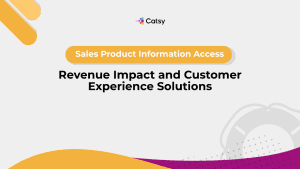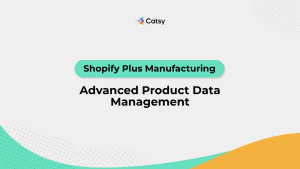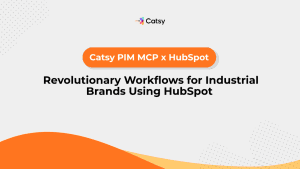Sales Product Information Access: Revenue Impact and Customer Experience Solutions
A Guide to Sales Product Information Access
- Elizabeth Byrd
- October 10, 2025
- 1:00 am

Table of Contents
What You'll Learn:
- Why sales reps spend only 28 percent of their time actually selling due to information hunting and administrative tasks
- How 70 percent of sales time gets wasted on non-selling activities including searching for specs and pricing data
- What organized information prevents by eliminating 20 percent of time wasted on research and data gathering
- How PIM systems boost sales productivity by 34 percent while improving forecast accuracy by 42 percent
- Why companies with organized product data grow revenue 80 percent faster than competitors with scattered information
It’s 2 PM on a Thursday afternoon. Your top sales rep is on a million-dollar prospect call. The customer asks about product compatibility, delivery times for custom specs, and volume pricing.
Your rep scrambles. The product catalog is six months old. Engineering specs live in three different systems. Pricing sheets are buried in someone’s email. The competitive analysis mentions features that may not exist anymore.
“Let me get back to you on those details,” your rep says for the third time.
The prospect goes quiet. They expected immediate answers. Your competitor gave them everything yesterday. The deal you’ve nurtured for four months starts slipping away because your sales team can’t access basic information.
By the time your rep finds answers, the prospect has moved on.
Sound familiar?
This happens daily across industries. When sales teams can’t find accurate product information quickly, every customer interaction becomes a missed opportunity.
1. Why Sales Teams Can't Find the Information They Need
Product complexity and customer expectations have created an information crisis that destroys sales effectiveness. Research shows sales reps spend only 28 percent of their time actually selling, with most time consumed by hunting for information and managing data instead of building relationships.
Information lives everywhere except where sales needs it. Product specs hide in engineering systems. Pricing sits in finance spreadsheets. Marketing materials exist in content platforms. Competitive intelligence stays in individual email accounts. When prospects ask questions, sales reps become detectives instead of trusted advisors.
The problem gets worse with complex products. Modern B2B solutions involve configurations, options, integration requirements, and regulations. 73 percent of customers expect companies to understand their unique needs, but sales reps can’t meet expectations without immediate access to comprehensive information.
Time waste compounds daily. Studies show sales reps spend 20 percent of their time researching prospects—a full workday each week. Add time hunting for product specs, confirming pricing, and validating claims, and reps lose over half their potential selling time to information activities.
Gartner research reveals buyers spend only 17 percent of their time meeting with suppliers during purchase processes. This limited face time demands maximum value from every interaction. When reps can’t access information quickly, they waste precious customer time on admin tasks instead of relationship building.
Customer expectations keep rising. Modern B2B buyers research extensively before engaging sales. Over 80 percent research before reaching out, arriving with specific questions about features, compatibility, pricing, and implementation. They expect immediate, accurate answers that demonstrate expertise.
This creates a vicious cycle: information delays frustrate customers, slow deals, lower close rates, and force reps to spend even more time on follow-up instead of new opportunities.
2. How Information Gaps Kill Revenue and Customer Trust
Information gaps create costs throughout the revenue engine while eroding competitive position and customer relationships. Companies face immediate revenue losses and long-term strategic damage when sales teams can’t access critical product data.
Productivity losses devastate performance. Sales reps spend 70 percent of their time on non-selling tasks, with information searching representing huge waste. When a $200K sales rep spends 30 percent of time hunting for product info, that’s $60K in lost productivity annually—before considering missed revenue opportunities.
Deal velocity slows with every delay. Each “let me get back to you” stops deal momentum. Prospects interpret delays as lack of expertise or product limitations. Customers expect immediate responses, and delays push them toward competitors who provide instant answers.
Win rates plummet from perceived incompetence. When reps can’t answer basic questions, customers question expertise and company capabilities. Customer confidence in information has the strongest impact on closing quality deals. Information gaps destroy confidence and reduce close rates.
Customer experience suffers lasting damage. Companies leading in customer experience grow revenue 80 percent faster, but information delays create frustrating experiences that drive customers to competitors.
Sales forecasting becomes unreliable when deal timelines extend due to information delays. Opportunities that should close in 30 days stretch to 60-90 days while reps gather info and coordinate approvals. This unpredictability makes planning difficult and reduces investor confidence.
Competitive position weakens systematically. While your reps search for information, competitors with organized data capture market share. McKinsey research shows companies can increase sales productivity by 3-5 percent through better information management.
The compound effect explains why sales information management has become strategic, not just operational. Companies that solve access problems consistently outperform those allowing teams to struggle with fragmented data.
3. What PIM Software Does to Fix Information Problems
Leading companies use Product Information Management (PIM) software to transform sales information chaos into competitive advantage. PIM systems centralize, organize, and distribute product information so sales teams access exactly what they need during live customer interactions.
Centralized repositories eliminate hunting. Instead of checking multiple systems for specs, pricing, and materials, PIM platforms provide single sources of truth where reps find all product information in one place. This reclaims hours daily that reps waste on searches.
Real-time sync ensures accuracy. When engineering updates specs, marketing revises positioning, or finance adjusts pricing, PIM systems automatically sync changes across all channels. Reps always work with current information, eliminating credibility damage from outdated data during customer conversations.
Smart search finds exactly what’s needed instantly. Advanced PIM systems understand product relationships, customer segments, and use cases. When reps search “industrial pump for chemical processing,” the system returns relevant products with appropriate specs, compatibility info, and pricing—not generic results requiring additional filtering.
Customer-specific delivery enhances consultative selling. PIM systems organize information by industry, application, or customer segment, enabling reps to access tailored content addressing specific needs. Rather than generic catalogs, reps get industry specs, relevant case studies, and targeted value propositions.
Mobile access enables field effectiveness. Modern PIM platforms provide mobile apps giving field reps immediate access to complete product information during customer visits. No more “let me follow up with specs”—reps answer questions and advance deals in real-time.
Automated content generation reduces prep time. Advanced systems automatically generate proposals, quotes, and presentations using current product info and customer requirements. This cuts proposal time from days to hours while improving accuracy.
Key PIM capabilities include:
- Unified catalogs with specs, pricing, and positioning
- Customer-specific content organization
- Mobile access for field teams
- CRM integration for seamless workflows
- Automated proposal and quote generation
- Real-time inventory and availability data
- Competitive comparison tools and battle cards
These capabilities transform sales from reactive information gathering to proactive value delivery that accelerates deals and improves customer experiences.
4. How Smart Sales Teams Build Competitive Advantages
Forward-thinking sales organizations use superior information management to accelerate revenue, improve relationships, and capture opportunities competitors miss due to information constraints.
Faster deal velocity becomes core competency when reps answer questions immediately instead of scheduling follow-ups. While competitors struggle with delays, equipped teams maintain momentum and advance opportunities faster.
Enhanced customer confidence emerges from information mastery. When reps provide immediate, accurate answers to technical questions, customers see them as knowledgeable experts rather than order-takers. This positioning enables consultative selling and premium pricing.
Better cross-selling results from complete visibility. Reps with comprehensive product information identify complementary products, compatibility requirements, and upgrade opportunities during every interaction. Companies using organized information systems experience up to 34 percent increases in sales productivity.
Improved forecasting accuracy enables strategic planning. When information delays don’t extend deal cycles unpredictably, forecasts become reliable. Management can plan resources, set realistic targets, and communicate confidently with investors.
Enhanced team performance reduces turnover. New reps become productive faster when they easily access product information. Experienced reps close deals more efficiently. Sales teams experience 25 percent average turnover when struggling with tools, but turnover decreases when information problems are solved.
Superior customer experience drives referrals. Customers receiving immediate, accurate information develop confidence in company capabilities. Companies with strong information delivery achieve 25 percent higher close rates and 10 percent higher order values.
Research shows companies implementing comprehensive PIM systems typically see sales productivity improvements within 90 days as information access barriers dissolve and reps redirect time toward revenue-generating activities.
Strategic advantages compound over time:
- Faster cycles enable higher volume per rep
- Better accuracy reduces post-sale support costs
- Improved experience strengthens competitive position
- Enhanced forecasting enables better planning
- Lower training costs improve team economics
- Increased referrals reduce acquisition costs
Companies establishing information excellence create sustainable advantages that become harder for competitors to match.
5. Why Your Information Strategy Must Be Future-Ready
B2B buying behavior shows information demands will keep intensifying as customers get more sophisticated and competition increases. Organizations building scalable information management now will leverage change while others struggle with mounting chaos.
Digital-first buying demands immediate access. Gartner projects 80 percent of B2B sales interactions will occur digitally by 2025, making information availability during digital touchpoints essential for success.
AI integration will transform delivery from manual search to predictive assistance. Advanced systems will analyze customer behaviors and deal histories to surface relevant information automatically. Reps won’t search—systems will predict and provide exactly what they need.
Personalization requires segmented strategies. 73 percent of consumers say experience is key in purchasing, demanding tailored information addressing specific industry needs and technical requirements. Generic catalogs become insufficient for competitive selling.
Mobile and remote selling demand cloud access. Sales teams work from anywhere and need immediate access to complete information regardless of location. Traditional systems requiring office networks become barriers to effectiveness.
Competitive intelligence integration becomes essential as markets crowd and differentiation gets harder. Teams need immediate access to not only their product information but also competitive comparisons and battle cards.
Future-ready capabilities must include:
- AI-powered information prediction and delivery
- Personalized content for customer segments
- Mobile-first access for remote teams
- Integrated competitive intelligence
- Automated compliance documentation
- Predictive analytics for information needs
Sales teams establishing advanced information management now will be prepared for accelerating demands while creating competitive barriers that strengthen market positions.
Key Takeaways
- Deploy centralized PIM systems that eliminate 70 percent of time reps waste on non-selling tasks like information hunting and data coordination.
- Implement real-time synchronization ensuring teams always have current specs, pricing, and positioning during customer interactions.
- Create customer-specific organization enabling reps to access tailored content addressing specific industry needs during consultative selling.
- Enable mobile access for field teams needing immediate product information during customer visits and virtual meetings.
- Integrate with CRM systems providing seamless workflows where product information flows automatically into sales processes.
- Measure access performance through metrics including search time, information accuracy, deal velocity, and rep productivity.
- Invest in AI-enhanced platforms that predict information needs and surface relevant content automatically during customer conversations.
FAQs:
How quickly can sales teams expect productivity improvements from PIM?
Most teams see improvements within 30-60 days of deployment. Early benefits include faster information access, reduced prep time, and improved customer response capability. Full productivity gains typically materialize within 90 days as teams adapt workflows.
What are the most common information gaps impacting sales performance?
Critical gaps include current pricing, product specifications, competitive comparisons, availability information, and regulatory documentation. Reps also struggle with customer-specific content, industry applications, and technical compatibility information.
How do PIM systems integrate with existing CRM and sales tools?
Modern platforms provide APIs and pre-built integrations for popular CRM systems like Salesforce, HubSpot, and Microsoft Dynamics. Integration involves data mapping, workflow configuration, and user training without requiring complete tool replacement.
What metrics should sales leaders track for information management effectiveness?
Key metrics include time spent searching, deal velocity, response time to inquiries, rep ramp time, forecast accuracy, and customer satisfaction scores. These help identify improvement opportunities and demonstrate system value.
How do PIM systems handle complex B2B product configurations?
Advanced platforms support complex product hierarchies, configuration rules, and customization options. They manage component relationships, enforce compatibility constraints, and generate accurate specifications for custom configurations while maintaining pricing accuracy.
Elizabeth Byrd
Consider multi-store architecture when you are facing significant regional product variations. Complex compliance requirements and distinct customer segments should also be considered.
Typically, manufacturing businesses will benefit from multi-store approaches. This is especially true if you’re serving markets with different safety standards or regulatory requirements. Remember, too, that business-to-business and business-to-consumer customers will have fundamentally different purchasing processes.
Effective inventory management requires integration between your stores and your legacy systems. This usually involves middleware solutions.
You can synchronize your stock levels, coordinate fulfillment, and manage your regional allocation strategies. The key lies in maintaining real-time visibility across each of your channels while enabling flexible fulfillment.
The primary challenges you may face include management of safety standards, tech documentation, and environmental regulations. Proper customs and import documentation may also come into pay.
Each market may require different certifications, testing procedures, and ongoing compliance monitoring, and these must be integrated into your multi-store operations.
The primary challenges you may face include management of safety standards, tech documentation, and environmental regulations. Proper customs and import documentation may also come into pay.
Each market may require different certifications, testing procedures, and ongoing compliance monitoring, and these must be integrated into your multi-store operations.





